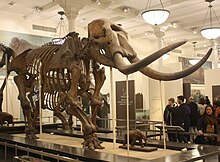
Back مستودون Arabic Mammut AST Mastodon Azerbaijani Мастодонти Bulgarian Mastodont Breton Mastodont Catalan Mastodon CEB Mastodont Czech Mastodont Danish Mammut (Gattung) German
| Mastodon | |
|---|---|

| |
| Mounted M. americanum skeleton ("Warren mastodon"), American Museum of Natural History | |
| Scientific classification | |
| Domain: | Eukaryota |
| Kingdom: | Animalia |
| Phylum: | Chordata |
| Class: | Mammalia |
| Order: | Proboscidea |
| Family: | †Mammutidae |
| Genus: | †Mammut Blumenbach, 1799 |
| Type species | |
| †Elephas americanus (= †Mammut americanum) Kerr, 1792
| |
| Other species | |
Species pending reassessment
| |
| Synonyms | |
|
Genus synonymy
Synonyms of M. americanum
Synonyms of M. matthewi Synonyms of M. vexillarius
Synonyms of M. raki
Synonyms of M. nevadanum
Synonyms of M. cosoensis
Synonyms of "M." borsoni Synonyms of "M." obliquelophus
| |
A mastodon (mastós 'breast' + odoús 'tooth') is a member of the genus Mammut (German for "mammoth"), which, strictly defined, was endemic to North America and lived from the late Miocene to the early Holocene. Mastodons belong to the order Proboscidea, the same order as elephants and mammoths (which belong to the family Elephantidae). Mammut is the type genus of the extinct family Mammutidae, which diverged from the ancestors of modern elephants at least 27–25 million years ago, during the Oligocene.
Like other members of Mammutidae, the molar teeth of mastodons have zygodont morphology (where parallel pairs of cusps are merged into sharp ridges), which strongly differ from those of elephantids. In comparison to its likely ancestor Zygolophodon, Mammut is characterized by particularly long and upward curving upper tusks, reduced or absent tusks on the lower jaw, as well as the shortening of the mandibular symphysis (the frontmost part of the lower jaw), the latter two traits also having evolved in parallel separately in elephantids. Mastodons had an overall stockier skeletal build, a lower-domed skull, and a longer tail compared to elephantids. Fully grown male M. americanum are thought to have been have been 275 cm (9.02 ft) to 305 cm (10.01 ft) at shoulder height and from 6.8 t (6.7 long tons; 7.5 short tons) to 9.2 t (9.1 long tons; 10.1 short tons) in body mass on average. The size estimates suggest that American mastodon males were on average heavier than any living elephant species; they were typically larger than Asian elephants and African forest elephants of both sexes but shorter than male African bush elephants.
M. americanum, known as an "American mastodon" or simply "mastodon," had a long and complex paleontological history spanning all the way back to 1705 when the first fossils were uncovered from Claverack, New York in the American colonies. Naturalists struggled to explain its affinities because of its uniquely shaped molars, which have no modern analogues in terms of large mammals. The American mastodon caught the attention of not only European researchers but also influential Americans before and after the American Revolution. American historians of the 21st century, such as Paul Semonin and Keith Stewart Thomson, have argued that findings and displays of its fossils had helped to bolster American nationalism and contributed to a greater understanding of extinctions. It is known by many skeletons which are now typically on display in American museums, a trend first started by Charles Willson Peale in 1804.
Taxonomically, M. americanum was first recognized as a distinct species by Robert Kerr in 1792 then classified to its own genus Mammut by Johann Friedrich Blumenbach in 1799, thus making it amongst the first fossil mammal genera to be erected with undisputed taxonomic authority. However, the original genus name was overshadowed by "Mastodon" in the 19th century, which was established formally by the French naturalist Georges Cuvier in 1817. The genus became problematic as it served as a wastebasket taxon for many species of proboscideans whose molar teeth morphology superficially resembled those of Mammut, but were not necessarily closely related. After major revisions of proboscidean taxonomy, the genus Mammut today is defined as the valid genus name and includes 7 definite species, 1 of questionable affinities, and 4 other species from Eurasia that are pending reassessments to other genera.
Mastodons are considered to have had a predominantly browsing-based diet on leaves, fruits, and woody parts of plants. This allowed mastodons to niche partition with other members of Proboscidea in North America, like gomphotheres and the Columbian mammoth, who had shifted to mixed feeding or grazing by the late Neogene-Quaternary. It is thought that mastodons behaviors not much different from elephants and mammoths, with females and juveniles living in herds, while adult males lived largely solitary lives and entered phases of aggression similar to the musth exhibited by modern elephants. Mammut achieved maximum species diversity in the Pliocene, though the genus is known from abundant fossil evidence in the Late Pleistocene.
Mastodons for at least a few thousand years prior to their extinction coexisted with Paleoindians, who were the first humans to have inhabited North America. Evidence has been found that Paleoindians (including those of the Clovis culture) hunted mastodons based on the finding of mastodon remains with cut marks and/or with lithic artifacts.
Mastodons disappeared along with many other North American animals, including most of its largest animals (megafauna), as part of the Late Pleistocene extinctions around the end of the Late Pleistocene-early Holocene, the causes typically being attributed to human hunting, severe climatic phases like the Younger Dryas, or some combination of the two. The American mastodon had its last recorded occurrence in the earliest Holocene around 11,000 years ago, which is considerably later than other North American megafauna species. Today, the American mastodon is one of the most well-known fossil species in both academic research and public perception, the result of its inclusion in American popular culture.
© MMXXIII Rich X Search. We shall prevail. All rights reserved. Rich X Search